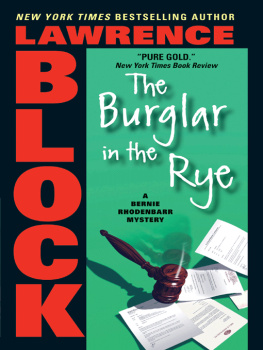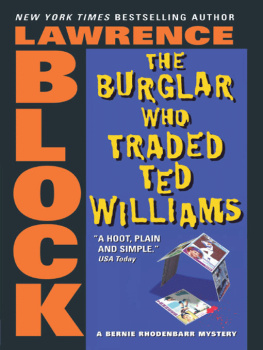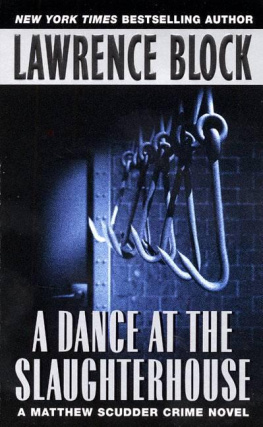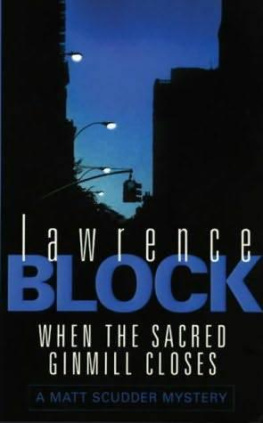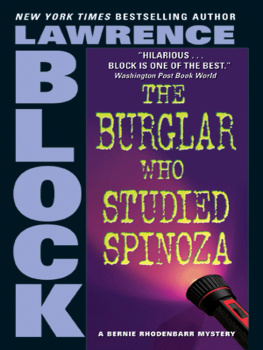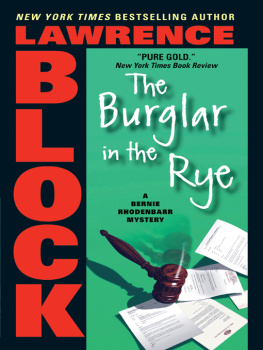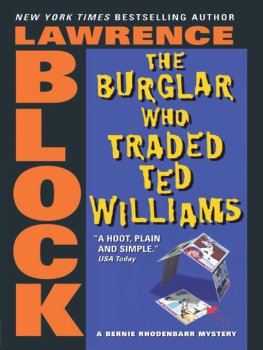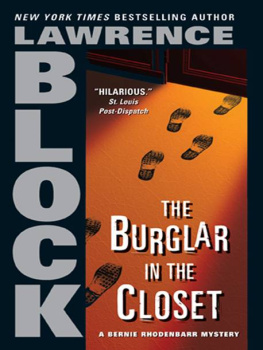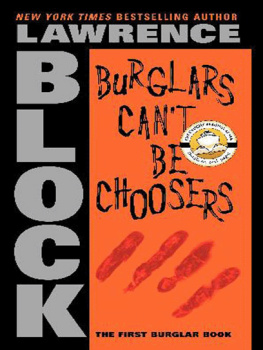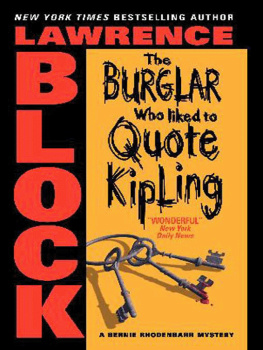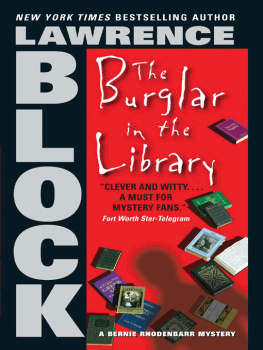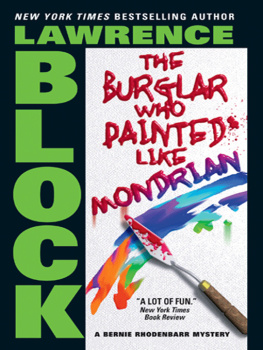The Burglar in the Rye
LAWRENCE BLOCK

this ones for Joe Pittman
CONTENTS
The lobby was a bit the worse for wear. The
The business is Barnegat Books, an antiquarian bookstore on East
Since Id missed lunch, you could say that Id had
The Paddington had a single stairwell, and the fire door
I didnt bide my time on the fire escape. I
I suppose I should begin at the beginning. It started
So this is rye, Carolyn said. It tastes a little
Gulliver Fairborn would have hated it.
It was Ray Kirschmann, wearing a dark blue suit and
Whatever youre doin, she growled, keep doin it. Words of
Kesslers Maryland Rye Whiskey, Martin Gilmartin pronounced, holding his glass
The cat uses the toilet, Henry Walden said. But of
I woke up eight hours later, well rested, glad to
But by then I was standing in the bathtub, cowering
Remarkably enough, I was open for business a few minutes
In the time I was gone, Henry had made a
A dead woman, I said.
It was getting on for nine that night by the
Ray Kirschmann scratched his head. I dunno, he said. Thems
Isis Gauthiers room was a lot nicer than mine. It
Everyone looked at Carl Pillsbury, and I have to hand
Bernie, she said, as if shed just been stabbed in
I have to say the fresh air was welcome. Isis
Some days later I was in the bookstore, tossing balls
I dont know, Bern, Carolyn said. Im confused.
The author is pleased to acknowledge his gratitude to the crew and passengers of the clipper ship Star Flyer, where much of the writing of this book was done en route from Phuket to Athens.
CHAPTER
One
T he lobby was a bit the worse for wear. The large oriental carpet had seen better days, lots of them. The facing Lawson sofas sagged invitingly and, like the rest of the furniture, showed the effects of long use. They were in use now; two women sat in animated conversation, and, a few yards away, a man with a long oval face and a high forehead sat reading a copy of GQ. He wore sunglasses, which made him look dapper and sly. I dont know how they made the magazine look. Dark, I suppose.
While the lobby may have been the least bit down at the heels, the overall impression was not so much of shabbiness as of comfort. The glow of a fire in the fireplace, a welcome sight on a brisk October day, put everything in the best possible light. And, centered above the fireplace mantel, painted with such il-tromping realism you wanted to reach out and pick him up and hug him, was the hotels namesake.
He was a bear, of course, but not the sort whose predilection for sylvan defecation is as proverbial as the Holy Fathers Catholicism. This bear, one saw at a glance, had never been to the woods, let alone behaved irresponsibly there. He was wearing a little red jacket, and he had a floppy royal blue rain hat on his head, and his legs ended in a pair of Wellington boots the color of a canary, and every bit as cheerful. He was perched on a shelf between a battered Gladstone grip and a shopping bag from Harrods, and a stenciled sign overhead proclaimed, Left Luggage, and
But I dont need to go on, do I? If you didnt have such a bear yourself, surely you knew someone who did. For this was Paddington Bear himself, and who else should it be? Who better to grace the lobby of the legendary Paddington Hotel?
And legendary was the word for it. The Paddington, seven stories of red brick and black ironwork, stands at the corner of Madison Avenue and East Twenty-fifth Street, across from Madison Square and not far from the site of Stanford Whites Madison Square Garden. (That was the second Madison Square Garden, as opposed to Garden #3, the one your father remembers at Eighth Avenue and Fiftieth Street, or the current entry, Garden #4, above Penn Station. Whites Garden was an architectural masterpiece, but then so was the original Penn Station. Sic transit damn near everything.)
But not the Paddington, which had gone up before the Garden and had lived to tell the tale. Built around the turn of the century, it had watched the neighborhood (and the city, and the world) reinvent itself continually over the years. For all that, the old hotel remained essentially the same. It had never been terribly grand, had always had more permanent residents than transient guests, and had from its earliest days drawn persons in the arts. Brass plaques flanking the entrance recorded some of the Paddingtons more prominent tenants, including the writers Stephen Crane and Theodore Dreiser and the Shakespearean actor Reginald French. John Steinbeck had spent a month there during a period of marital disharmony, and Robert Henri, the Ashcan School artist, had stayed at the Paddington before relocating a few blocks south and east at Gramercy Park.
More recently, the hotel had drawn touring British rock stars, who seemed less inclined to destroy rooms here than in other American hotels, either out of respect for its traditions or from a sense that the damage they did might go unnoticed. Two of them had died on the premises, one murdered by a drifter hed brought back to his room, the other more conventionally of a heroin overdose.
Classical music was represented as well, by at least two of the permanent residents, and the occasional performer on tour. An octogenarian pianist, Alfred Hertel, whose annual Christmas concert at Carnegie Hall was always sold out, had occupied an apartment on the top floor for over forty years. At the opposite end of the same floor lived the aging diva Sonia Brigandi, whose legendary temperament survived the decline of her legendary soprano voice. Once in a while one or both of them would leave their doors open, and one would play what the other would sing, thrilling (or annoying) the other residents with something from Puccini or Verdi or Wagner.
Other than that they didnt speak. Rumors aboundedthat theyd had an affair, that theyd been rivals for some other tenants affections. He was said to be gay, although hed been married twice and had children and grandchildren. She had never married and was said to have had lovers of both sexes. And both of them were supposed to have slept with Edgar Lee Horvath, whod never slept with anyone. Except for his bears, of course.
It was Horvath, the founder of Pop Realism, who had painted the Paddington Bear over the lobby fireplace. Hed taken rooms in the hotel in the mid-sixties, shortly after the success of his first one-man show, and had lived there until his death in 1979. The painting had been a gift to the hotel, given early in his stay, and, with the sharp increase in value of Horvaths works since his death, it was probably worth close to a million dollars. And there it was, hanging right there in plain sight, in an essentially unguarded lobby.
Of course a person would have to be crazy to steal it. Edgar Horvath had painted a whole series of teddy bears, from bedraggled early Stieff creations to contemporary plush creatures, and a teddy bear of one sort or another was invariably present in his portraits and landscapes and interiors. His desert landscapes, done during a brief stay in Taos, show bears sprawled at the foot of an enormous cactus, or straddling a fence rail, or propped up against an adobe wall.
But, as far as anyone knew, hed only painted Paddington once. And that painting hung famously in the hotels famously threadbare lobby. It was there for the taking, but so what? If you hooked that painting, how and to whom would you sell it?

